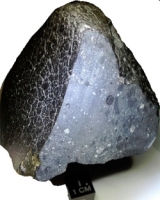
January Editorial
Martian Meteorite - Northwest Africa (NWA) 7034 stands alone

January Editorial
Martian Meteorite - Northwest Africa (NWA) 7034 stands alone
|
|
Most of the knowledge about the chemistry of Mars comes from Martian meteorites known as the SNC group (from the three types of meteorite in the group: Shergotty, Nakhla, and Chassigny). These meteorites are not only rare but until recently were the only samples from Mars that scientists have been able to study. Furthermore their precise origin is unknown and recent data from lander and orbiter missions suggest that they are a mismatch for the Martian crust. |
|
|
Recent extensive study of another Martian meteorite (called Northwest Africa [NWA] 7034) show that this meteorite probably does originate from Mars’ crust. Although Northwest Africa (NWA) 7034, shares some similarities with the SNC group, this meteorite also has unique features. Northwest Africa (NWA) 7034 was found in the Sahara Desert in 2011. As with many meteorites nowadays, it was then purchased by a meteorite dealer. The dealer sold this specimen on to a private collector in the United States. Therefore the exact geographic location where the meteorite was originally found is not known. In situations such as this, the meteorites are named by the geographic region and a number which is given out consecutively. Hence the technical name which the meteorite bears. But scientists have nicknamed this particular specimen 'Black Beauty'. The owner of Northwest Africa (NWA) 7034 donated a slice of his possession to the University of New Mexico for scientist Carl Agee to study in collaboration with researchers from the Carnegie Institution for Science. Extensive chemical analysis of the donated sample revealed that this meteorite was one of a kind. As mentioned earlier, all other known Martian meteorites fit into the SNC classification. Of these roughly 75% are shergottities - igneous rocks high in magnesium and iron. One of the puzzling things about shergottities is that they seem to be very young rocks which crystallized only about 180 million years ago. This makes them very young in comparison to the age of Mars itself - a paradox still hotly debated amongst scientists. However, it was discovered that Northwest Africa (NWA) 7034 is much older. The researchers estimate that it was formed during the early Amazonian epoch of Mars’ geologic history, some 2.1 billion years ago. Carbon analysis of the NWA meteorite showed that geochemically it resembles enriched crustal rock similar to basalt. The chemistry is comparable to the results extrapolated from data from recent Mars rover and orbiter missions. Co-author Andrew Steele, who led the carbon analysis at the Carnegie Institution's Geophysical Laboratory explained: "The texture of the NWA meteorite is not like any of the SNC meteorites. It is made of cemented fragments of basalt, rock that forms from rapidly cooled lava, dominated with feldspar and pyroxene, most likely from volcanic activity. This composition is common for lunar samples, but not from other Martian meteorites. This unusual meteorite's chemistry suggests it came from the Martian crust. It is the first link thus far of any meteorite to the crust". An exciting discovery was the abundance of indigenous water within the meteorite. This was an order of magnitude more than in most SNC meteorites. This high water content could mean that the rocks interacted with surface water from volcanic magma, or from fluids from impacting comets at the time when the meteorite formed. Those unique features of Northwest Africa (NWA) 7034 mean that the meteorite does not fit into any of the existing SNC meteorite categories. It has at present been put into a new Martian meteorite group named "Martian (basaltic breccia)" and so far it is the group's only member. This latest research on NWA 7034 was published online in Science. See the reference below. Journal Reference: | |
| _______________________________ | ||||
| Home | | | Shopping | | | Database |
© Biscuit Software 2004-2015
All rights reserved